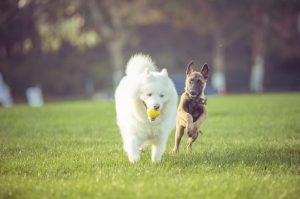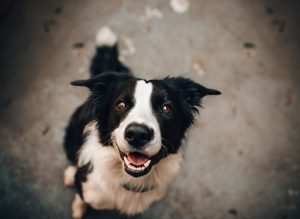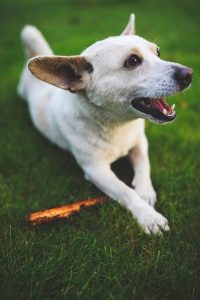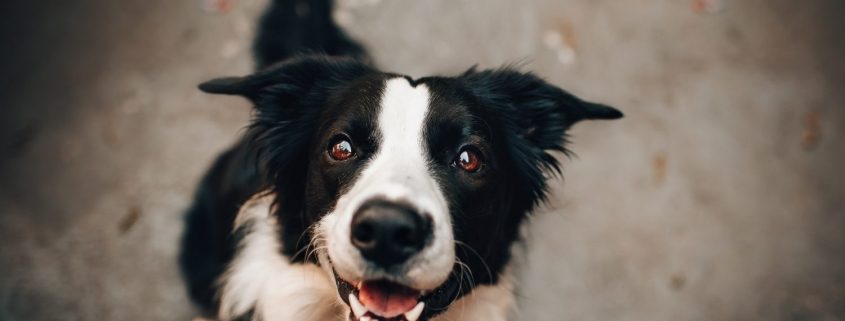Ask Crystal: Basic Cues to Help Excited Dog Behavior
Welcome to “Ask Crystal,” where you can ask your pet behavior questions! You can submit your question for Crystal at the bottom of the page!
Dear Crystal,
I recently got a new puppy and overall things are going really great with him. Our main issue right now is how happy and excited he is to meet new people and dogs. He just can’t seem to contain his excitement. We would like to socialize him in hopes this will help him calm down. Any suggestions?
Sincerely,
Calm Down Rover
Dear Calm,
 Dogs are not born with impulse control, but they can learn it through experiences with people and other dogs. It might be a good option to take him to doggie daycare so that he can learn from other dogs that out of control greetings and play do not get rewarded with playtime. I am suggesting doggie daycare rather than a dog park because there will be staff to monitor appropriate play. Dog parks can many times be a free for all of rude dog behavior with no one interrupting behavior and could teach him some new bad habits. Daycare alone will probably not be enough to teach him the skills he needs to be able to calm himself. We can use training to teach our dogs that being calm is an option. I have met many dogs who don’t seem to realize that sometimes they should be calm. As we are training our dogs, we should reward offered polite, calm behaviors so that dogs can start to experiment and learn that it can be rewarding to have some self-control. We can also start working on teaching our dogs to show self-control and listen to us in the face of excitement.
Dogs are not born with impulse control, but they can learn it through experiences with people and other dogs. It might be a good option to take him to doggie daycare so that he can learn from other dogs that out of control greetings and play do not get rewarded with playtime. I am suggesting doggie daycare rather than a dog park because there will be staff to monitor appropriate play. Dog parks can many times be a free for all of rude dog behavior with no one interrupting behavior and could teach him some new bad habits. Daycare alone will probably not be enough to teach him the skills he needs to be able to calm himself. We can use training to teach our dogs that being calm is an option. I have met many dogs who don’t seem to realize that sometimes they should be calm. As we are training our dogs, we should reward offered polite, calm behaviors so that dogs can start to experiment and learn that it can be rewarding to have some self-control. We can also start working on teaching our dogs to show self-control and listen to us in the face of excitement.
 The most basic cue of “sit” is a great polite default behavior. Once the dog is able to sit, we can begin to start asking them to sit before they get anything they want. Ask for a sit for the food bowl, the leash being put on for a walk or being taken off to go play with other dogs. When your dog becomes accustomed to the routine, start waiting for him to offer sits at these times. Be patient and wait him out to see if he can figure it out. When we start to wait for our dogs to offer polite behaviors rather than always cueing them, they start to offer polite, calm behaviors on their own. Games of fetch are a great way to incorporate this training. Teach him to drop the ball by placing a high value treat up to his nose while the ball is in his mouth and say, “drop it”, when he does, say “yes” and treat. Ask for a sit and wait and then toss the ball. Repeat this process for every throw and start to increase the amount of time that you ask him to wait slowly.
The most basic cue of “sit” is a great polite default behavior. Once the dog is able to sit, we can begin to start asking them to sit before they get anything they want. Ask for a sit for the food bowl, the leash being put on for a walk or being taken off to go play with other dogs. When your dog becomes accustomed to the routine, start waiting for him to offer sits at these times. Be patient and wait him out to see if he can figure it out. When we start to wait for our dogs to offer polite behaviors rather than always cueing them, they start to offer polite, calm behaviors on their own. Games of fetch are a great way to incorporate this training. Teach him to drop the ball by placing a high value treat up to his nose while the ball is in his mouth and say, “drop it”, when he does, say “yes” and treat. Ask for a sit and wait and then toss the ball. Repeat this process for every throw and start to increase the amount of time that you ask him to wait slowly.
 “Down” is my absolute favorite behavior for teaching a dog to be calm. Start in a calm, low distraction environment like your house and have the dog lie down and calmly reward as often as needed to staying lying down for a few minutes. If you haven’t worked on your stay yet, your dog may not be familiar with lying down for long periods of time. If that is the case, then start by having the dog lie down for about 10 seconds and feed him treats while he is lying down. Slowly start to build up the duration until he can lie down for a few minutes while you slowly feed him treats. After you have practiced at home, go to a quiet spot to practice and then start to practice in increasingly more difficult places. There are some very helpful relaxation training games which use down in increasingly distracting situations. I like both Dr Karen Overall’s Relaxation Protocol and Suzanne Clothier’s Really Real Relaxation Protocol for different reasons. I find myself using Suzanne Clothier’s most often with my own dogs and adoption center dogs because it is really practical, and dogs start to generalize really quickly with it.
“Down” is my absolute favorite behavior for teaching a dog to be calm. Start in a calm, low distraction environment like your house and have the dog lie down and calmly reward as often as needed to staying lying down for a few minutes. If you haven’t worked on your stay yet, your dog may not be familiar with lying down for long periods of time. If that is the case, then start by having the dog lie down for about 10 seconds and feed him treats while he is lying down. Slowly start to build up the duration until he can lie down for a few minutes while you slowly feed him treats. After you have practiced at home, go to a quiet spot to practice and then start to practice in increasingly more difficult places. There are some very helpful relaxation training games which use down in increasingly distracting situations. I like both Dr Karen Overall’s Relaxation Protocol and Suzanne Clothier’s Really Real Relaxation Protocol for different reasons. I find myself using Suzanne Clothier’s most often with my own dogs and adoption center dogs because it is really practical, and dogs start to generalize really quickly with it.
“Leave it” is an essential daily cue in my life and is also a great self-control exercise. Leave it means to take your mouth or nose off of whatever it is currently on or going towards. I teach this cue in three parts. The first two parts we aren’t showing the dog the food, but he can smell the food. This way we teach the rules of the game but make it a little bit easier than showing the food to the dog outright. I have food in both hands for this exercise. I put something mildly interesting like biscuits in one hand and present that hand in a fist to the dog. In the other hand, I have more valuable treats and I put that behind my back. I present the fist on the ground to the dog. Most dogs will come sniff at the hand. What I am looking for here is the nose to come off of the hand and I will “yes” and treat. Eventually the dog will stop nosing the fist and offer eye contact. I then make my criteria eye contact. Once the dog is reliably offering eye contact, I place my hand with the biscuits flat on the ground. I repeat the entire process. Once the dog is again reliably offering eye contact, I will move on to step three where I am showing the dog the food. I will lift my flat hand up like a lid and show the food to the dog. When the dog lunges for the food, I say, “leave it” and cover the food up. When the nose comes of the hand, “yes” and treat. If the dog offers eye contact rather than lunging for the food, I will reward that as well. This reinforces the dog for checking in with you rather than lunging for the food. Now that is self-control!
I would suggest that you begin training your new puppy with all of these techniques. While he is in training, avoid allowing him to greet people or dogs while on leash. Until he has had a lot of time to practice his new skills, he shouldn’t be allowed to practice over the top greetings. Practice polite greetings with friends who have dogs or attend a group training class where you can practice his new skills around people and dogs. These training techniques will go so much further than just helping with greeting new people and dogs. Self-control is an essential skill that will make your puppy so much easier to live with and be on the way to a polite dog.
Until next time,
Crystal







